
Deutsch-Chinesische Enzyklopädie, 德汉百科
 中国
中国
 *中国足球协会超级杯冠军
*中国足球协会超级杯冠军
 *中国足球超级联赛冠军
*中国足球超级联赛冠军
 *中国足协杯冠军
*中国足协杯冠军
 亚洲足球俱乐部冠军联赛 2015
亚洲足球俱乐部冠军联赛 2015
 阿尔贝托·扎切罗尼
阿尔贝托·扎切罗尼
 北京市-京
北京市-京
 中国
中国
 中国足球超级联赛 2016
中国足球超级联赛 2016
 北京国安足球俱乐部
北京国安足球俱乐部
 中国足球超级联赛 2017
中国足球超级联赛 2017
 北京国安足球俱乐部
北京国安足球俱乐部
 中国足球超级联赛 2018
中国足球超级联赛 2018
 中国足球超级联赛 2019
中国足球超级联赛 2019
 中国足球超级联赛 2020
中国足球超级联赛 2020
 中国足球超级联赛 2021
中国足球超级联赛 2021
 中国足球超级联赛 2022
中国足球超级联赛 2022
 中国足球超级联赛 2023
中国足球超级联赛 2023
 中国足球超级联赛 2024
中国足球超级联赛 2024
 中国足球超级联赛 2025
中国足球超级联赛 2025

 体育
体育

 体育
体育
 (F)中国足球超级联赛
(F)中国足球超级联赛
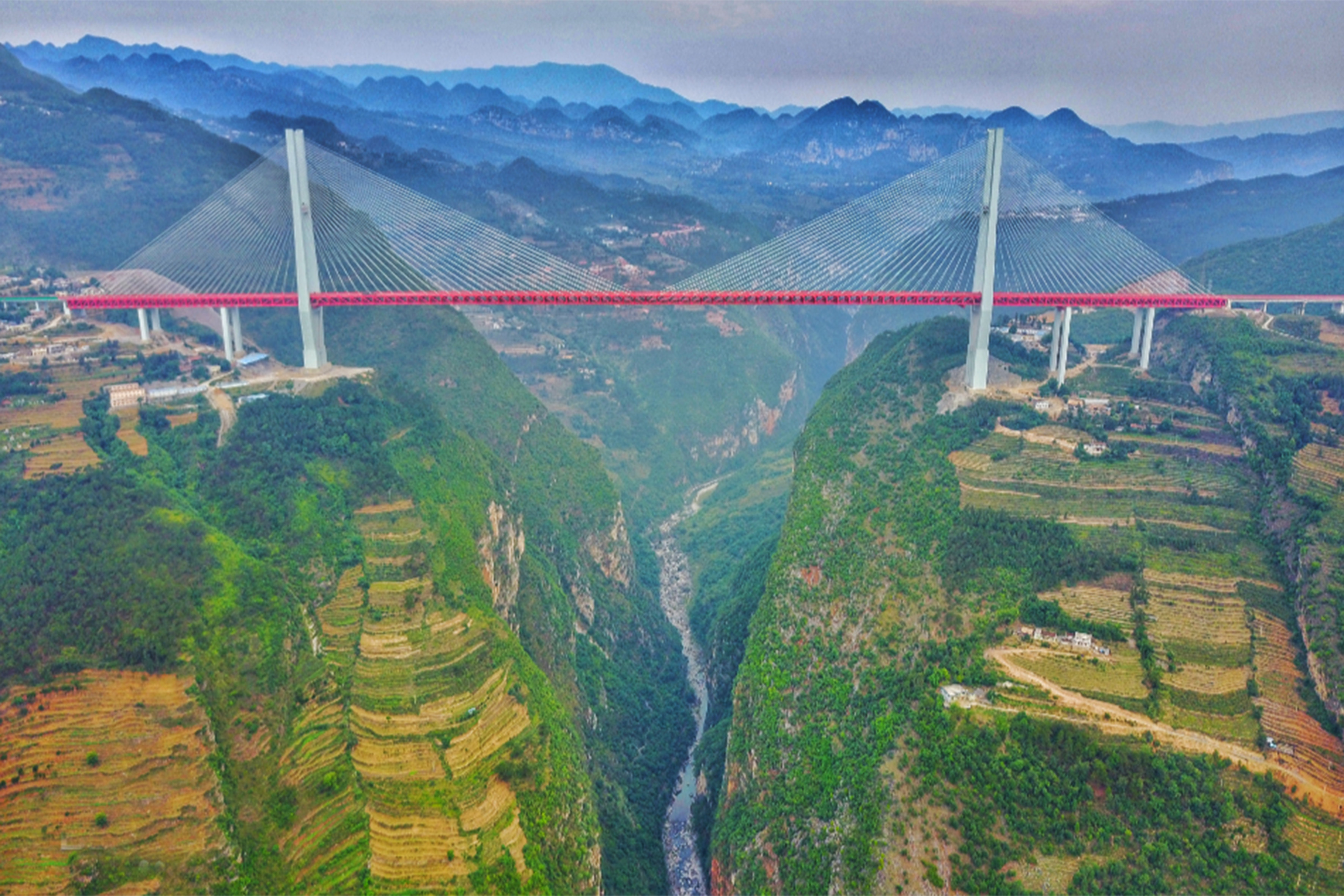
Die Beipanjiang-Brücke (chinesisch 北盘江特大桥, Pinyin Běipánjiāng Tèdàqiáo; im Chinesischen auch mit der Bezeichnung Nizhu He Daqiao 尼珠河大桥 „Große Nizhu-He-Brücke“; im Englischen auch Duge Bridge nach der gleichnamigen Gemeinde im Kreis Shuicheng) ist eine 1341 m lange Schrägseilbrücke in China, die mit ihrer Höhe von 565 m über dem Talgrund die Siduhe-Brücke als höchste Brücke der Welt ablöst. Das letzte Teilstück wurde am 10. September 2016 eingefügt.[3] Das Bauwerk wurde am 29. Dezember 2016 für den Verkehr freigegeben.[4]
 亚历山大·武契奇
亚历山大·武契奇
 阿列克西斯·齐普拉斯
阿列克西斯·齐普拉斯
 亚历山大·卢卡申科
亚历山大·卢卡申科
 阿尔马兹别克·阿坦巴耶夫
阿尔马兹别克·阿坦巴耶夫
 昂山素季
昂山素季

 北京市-京
北京市-京
 一带一路国际合作高峰论坛
一带一路国际合作高峰论坛
 本扬·沃拉吉
本扬·沃拉吉
 多丽丝·洛伊特哈尔德
多丽丝·洛伊特哈尔德
 扎尔格勒图勒嘎·额尔登巴特
扎尔格勒图勒嘎·额尔登巴特
 联合国秘书长
联合国秘书长
 安东尼奥·古特雷斯
安东尼奥·古特雷斯
 海尔马里亚姆·德萨莱尼
海尔马里亚姆·德萨莱尼

 手拉手
手拉手
 洪森
洪森
 国际可再生能源机构
国际可再生能源机构
 阿德南·阿明
阿德南·阿明
 国际货币基金组织
国际货币基金组织
 克里斯蒂娜·拉加德
克里斯蒂娜·拉加德
 国际刑事警察组织
国际刑事警察组织
 于尔根·施托克
于尔根·施托克
 佐科·维多多
佐科·维多多
 李克强
李克强
 马里亚诺·拉霍伊
马里亚诺·拉霍伊
 毛里西奥·马克里
毛里西奥·马克里
 米歇尔·巴切莱特
米歇尔·巴切莱特
 纳吉·阿都拉萨
纳吉·阿都拉萨
 纳瓦兹·谢里夫
纳瓦兹·谢里夫
 努尔苏丹·纳扎尔巴耶夫
努尔苏丹·纳扎尔巴耶夫
 保罗·真蒂洛尼
保罗·真蒂洛尼
 联合国大会主席
联合国大会主席
 彼得·汤姆森
彼得·汤姆森
 拉尼尔·维克勒马辛哈
拉尼尔·维克勒马辛哈
 雷杰普·塔伊普·埃尔多安
雷杰普·塔伊普·埃尔多安
 罗德里戈·杜特尔特
罗德里戈·杜特尔特
 丝绸之路
丝绸之路
 肖开提·米尔则亚耶夫
肖开提·米尔则亚耶夫

 乌胡鲁·肯雅塔
乌胡鲁·肯雅塔
 联合国教育、科学及文化组织
联合国教育、科学及文化组织
 伊琳娜·博科娃
伊琳娜·博科娃
 欧尔班·维克多
欧尔班·维克多
 世界银行
世界银行
 金墉
金墉

 经济和贸易
经济和贸易
 弗拉基米尔·弗拉基米罗维奇·普京
弗拉基米尔·弗拉基米罗维奇·普京
 世界经济论坛
世界经济论坛
 克劳斯·施瓦布
克劳斯·施瓦布
 世界卫生组织
世界卫生组织
 陈冯富珍
陈冯富珍
 世界贸易组织
世界贸易组织
 罗伯托·阿泽维多
罗伯托·阿泽维多
 习近平
习近平
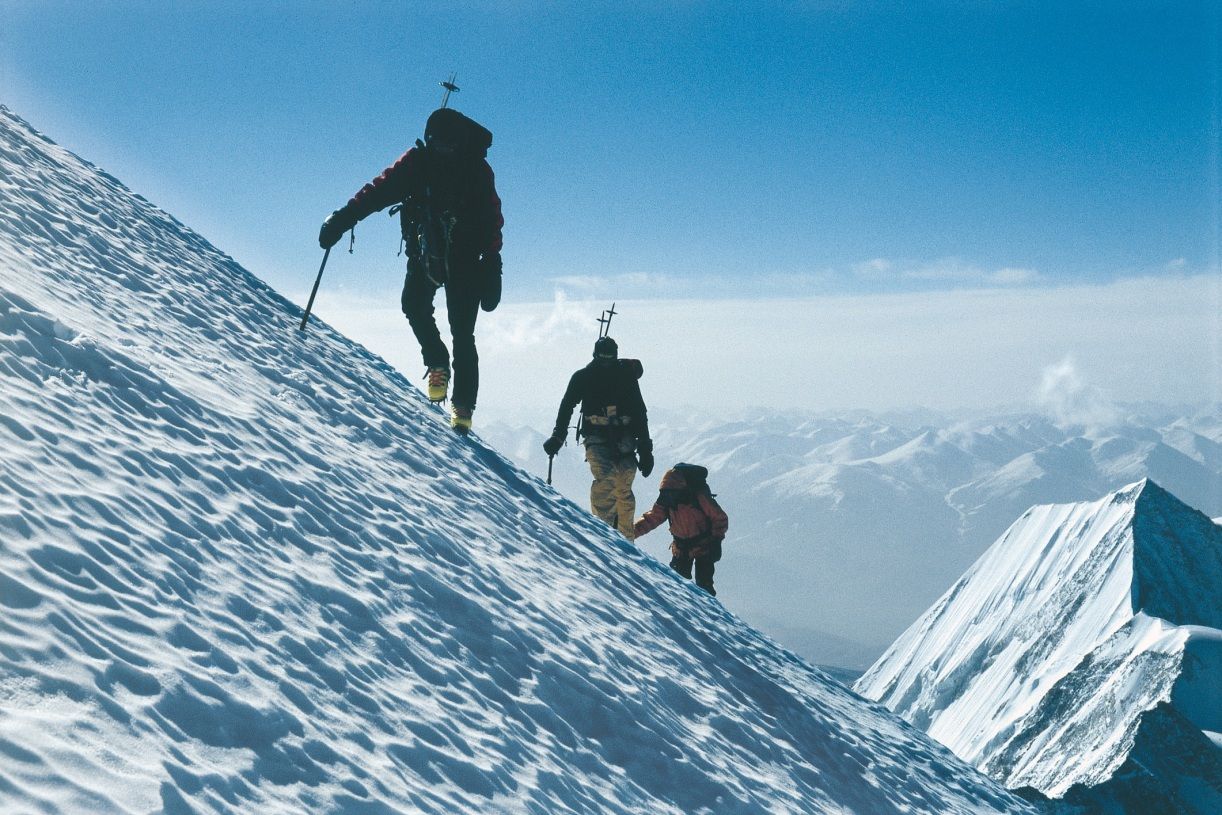

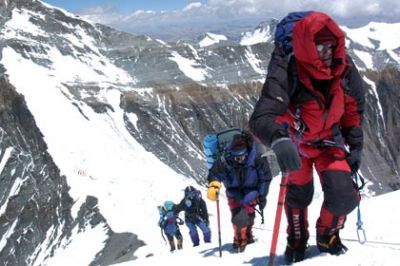
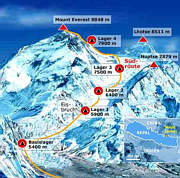
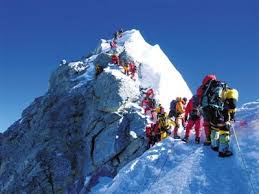

珠穆朗玛峰山体呈巨型金字塔状,威武雄壮昂首天外,地形极端险峻,环境异常复杂。雪线高度:北坡为5800—6200米,南坡为5500—6100米。东北山脊、 东南山脊和西山山脊中间夹着三大陡壁(北壁、东壁和西南壁),在这些山脊 和峭壁之间又分布着548条大陆型冰川,总面积达1457.07平方公里,平均厚度达7260米。冰川的补给主要靠印度洋季风带两大降水带积雪变质形成。冰川上 有千姿百态、瑰丽罕见的冰塔林,又有高达数十米的冰陡崖和步步陷井的明暗 冰裂隙,还有险象环生的冰崩雪崩区。(Quelle:http://news.xinhuanet.com)
珠穆朗玛峰(藏文:ཇོ་མོ་གླང་མ;藏语拼音:qomolangma;威利:jo mo glang ma,香港称珠穆朗玛峰,台湾称圣母峰),中文简称珠峰,尼泊尔名萨加玛塔峰(尼泊尔语:सगरमाथा),英国名埃佛勒斯峰(英语:Mount Everest),为地球第一高峰,属于喜马拉雅山脉,位于中国西藏自治区与尼泊尔萨加玛塔专区边界上。2005年中国国家测绘局测量的岩面高为8,844.43米(29,017.2英尺),尼泊尔则使用传统的雪盖高8,848米(29,029英尺),BBC报道称2010年起两国官方互相承认对方的测量数据[5],中国国家测绘地理信息局则在2018年2月声明否认此说法,仍采用8,844.43米数据至今[6]。它除了是海拔最高的山峰之外,也是距离地心第五远的高峰。[7]它附近的高峰包括8,516米(27,940英尺)的洛子峰、7,855米(25,771英尺)的努子峰和7,580米(24,870英尺)的章子峰。
清朝经过测绘于1719年出版的全国地图上称此峰为“朱姆朗马阿林”,但没有标出高度或用经纬度标出其位置。1856年英属印度测量局首次公布此峰的经纬度及海拔高度,主张此峰8,840米(29,000英尺)是世界第一高峰。1865年英国皇家地理学会接受印度测量局局长安德鲁·史考特·华欧的建议,将此峰命名为“埃佛勒斯峰”,以纪念前任局长乔治·埃佛勒斯。1952年,中国采用“珠穆朗玛峰”为官方名称。
珠穆朗玛峰吸引了许多登山者。主要的攀登路线有两条,一条从尼泊尔东南部出发,经过与洛子峰之间的南坳登顶,称为“标准路线”;另一条则从西藏的北部出发,经过与章子峰之间的北坳登顶。从标准路线登顶对登山技术的挑战不算高,但这条路线的风险包括雪崩、摔落山谷、高山症、冻伤和通过昆布冰瀑的危险。到2016年为止,山上有超过200具尸体,其中一些成为地标。[8][9]
据气象记载,珠穆朗玛峰山顶最低温度为-60°C,最低月平均温度为-35°C,全年平均温度为-29°C,参照北极、南极,因此也被称为“世界第三极”。[10]
Der Mount Everest ist ein Berg im Himalaya und mit einer Höhe von 8848 m der höchste Berg der Erde. Er gehört zu den 14 Achttausendern und zu den Seven Summits. Der Mount Everest ist seit 1856 nach dem britischen Landvermesser George Everest benannt. Auf Nepali heißt der Berg Sagarmatha, auf Tibetisch Qomolangma (deutsche Aussprache „Tschomolangma“; englische Umschrift Chomolungma).
Der Mount Everest befindet sich im Mahalangur Himal in der Region Khumbu in Nepal an der Grenze zu China (Autonomes Gebiet Tibet); der westliche und südöstliche seiner drei Gipfelgrate bilden die Grenze. Auf nepalesischer Seite ist er Teil des Sagarmatha-Nationalparks, der zum UNESCO-Welterbe gehört. Auf der Nordseite gehört er zum Qomolangma National Nature Reserve, das mit dem von der UNESCO ausgewiesenen Qomolangma-Biosphärenreservat korrespondiert.[1]
Edmund Hillary und Tenzing Norgay gelang am 29. Mai 1953 die Erstbesteigung des „dritten Pols“. Am 8. Mai 1978 bestiegen Reinhold Messner und Peter Habeler den Gipfel erstmals ohne zusätzlichen Sauerstoff.
エベレスト、エヴェレスト(英: Everest)、またはチョモランマ(チベット語: ཇོ་མོ་གླང་མ[1] Chomolungma, Qomolangma)、サガルマータ(ネパール語: सगरमाथा Sagarmāthā)は、ヒマラヤ山脈にある世界最高峰である。
エベレストはインド測量局(Survey of India)で長官を務めたジョージ・エベレストにちなんで命名された。
1920年代から長きにわたる挑戦の末、1953年にイギリス探検隊のメンバーでニュージーランド出身の登山家であるエドモンド・ヒラリーとネパール出身のシェルパであるテンジン・ノルゲイによって初登頂がなされた。
エベレストの標高については諸説あり、1954年にインド測量局が周辺12ヶ所で測定しその結果を平均して得られた8,848 mという数値が長年一般に認められてきた。1999年、全米地理学協会はGPSによる測定値が8,850mだったと発表した[2]。厳密には地殻変動などの影響によって標高は年々変動していると考えられている。
エベレストの南麓に位置するネパールのサガルマータ国立公園はユネスコの世界遺産に登録されている。
Mount Everest, known in Nepali as Sagarmatha (सगरमाथा) and in Tibetan as Chomolungma (ཇོ་མོ་གླང་མ), is Earth's highest mountain above sea level, located in the Mahalangur Himal sub-range of the Himalayas. The international border between Nepal (Province No. 1) and China (Tibet Autonomous Region) runs across its summit point.
The current official elevation of 8,848 m (29,029 ft), recognized by China and Nepal, was established by a 1955 Indian survey and subsequently confirmed by a Chinese survey in 1975.[1] In 2005, China remeasured the rock height of the mountain, with a result of 8844.43 m. There followed an argument between China and Nepal as to whether the official height should be the rock height (8,844 m., China) or the snow height (8,848 m., Nepal). In 2010, an agreement was reached by both sides that the height of Everest is 8,848 m, and Nepal recognizes China's claim that the rock height of Everest is 8,844 m.[5]
In 1865, Everest was given its official English name by the Royal Geographical Society, upon a recommendation by Andrew Waugh, the British Surveyor General of India. As there appeared to be several different local names, Waugh chose to name the mountain after his predecessor in the post, Sir George Everest, despite George Everest's objections.[6]
Mount Everest attracts many climbers, some of them highly experienced mountaineers. There are two main climbing routes, one approaching the summit from the southeast in Nepal (known as the "standard route") and the other from the north in Tibet. While not posing substantial technical climbing challenges on the standard route, Everest presents dangers such as altitude sickness, weather, and wind, as well as significant hazards from avalanches and the Khumbu Icefall. As of 2017, nearly 300 people have died on Everest, many of whose bodies remain on the mountain.[7]
The first recorded efforts to reach Everest's summit were made by British mountaineers. As Nepal did not allow foreigners into the country at the time, the British made several attempts on the north ridge route from the Tibetan side. After the first reconnaissance expedition by the British in 1921 reached 7,000 m (22,970 ft) on the North Col, the 1922 expedition pushed the north ridge route up to 8,320 m (27,300 ft), marking the first time a human had climbed above 8,000 m (26,247 ft). Seven porters were killed in an avalanche on the descent from the North Col. The 1924 expedition resulted in one of the greatest mysteries on Everest to this day: George Mallory and Andrew Irvine made a final summit attempt on 8 June but never returned, sparking debate as to whether or not they were the first to reach the top. They had been spotted high on the mountain that day but disappeared in the clouds, never to be seen again, until Mallory's body was found in 1999 at 8,155 m (26,755 ft) on the north face. Tenzing Norgay and Edmund Hillary made the first official ascent of Everest in 1953, using the southeast ridge route. Norgay had reached 8,595 m (28,199 ft) the previous year as a member of the 1952 Swiss expedition. The Chinese mountaineering team of Wang Fuzhou, Gonpo, and Qu Yinhua made the first reported ascent of the peak from the north ridge on 25 May 1960.[8][9]
L’Everest, en tibétain ཇོ་མོ་གླང་མ, Qomolangma ou encore Chomolungma, en népalais सगरमाथा, Sagarmāthā, aussi appelé mont Everest, est une montagne située dans la chaîne de l'Himalaya, à la frontière entre le Népal (province no 1 (en)) et la Chine (Tibet).
Il est aperçu par des Européens pour la première fois en 1847 puis, après quelques années d'observations et de calculs, son altitude est établie à 8 848 mètres et il est identifié comme le plus haut sommet du monde. Cette caractéristique lui vaut d'être baptisé de son nom actuel par les Occidentaux en 1865 et, dès les années 1920, de lui attirer l'intérêt des alpinistes qui se lancent à l'assaut de ses pentes. Plusieurs expéditions, en particulier britanniques, se succèdent depuis le versant nord au Tibet. Toutefois, les conditions climatiques extrêmes font leurs premières victimes, parmi lesquelles George Mallory et Andrew Irvine, en 1924, dont on ne saura probablement jamais avec certitude s'ils ont atteint le sommet. En 1950, le Népal autorise l'accès à la montagne depuis le sud offrant des possibilités d'ascension par l'arête Sud-Est, moins périlleuse. Finalement, trois ans plus tard, Edmund Hillary et Tensing Norgay réussissent à vaincre l'Everest. Dès lors, les exploits en tous genres s'enchaînent, alimentant les fantasmes populaires ; mais, en 1996, une série d'accidents mortels vient rappeler les dangers liés à la montagne, portant de nos jours à plus de 200 le nombre de victimes. Pourtant, le tourisme de masse se popularise, fragilisant le milieu naturel malgré les créations du parc national de Sagarmatha en 1976 et de la réserve naturelle du Qomolangma en 1988. Ainsi, plus de 14 000 alpinistes ont tenté l'ascension depuis 1922 et plus de 4 000 l'ont réussie, bien aidés, pour la majorité d'entre eux, par les porteurs sherpas.
Il monte Everest (pron. /ˈɛverest/[1]) è la vetta più alta del continente asiatico e della Terra con i suoi 8 848 m di altitudine s.l.m., situato nella catena dell'Himalaya assieme ad altri ottomila, al confine fra Cina e Nepal. Rientra dunque nelle cosiddette Sette Vette del Pianeta.
El monte Everest es la montaña más alta del planeta Tierra, con una altitud de 8.848 metros (29 029 pies) sobre el nivel del mar.1 Está localizada en el continente asiático, en la cordillera del Himalaya, concretamente en la subcordillera de Mahalangur Himal; marca la frontera entre China y Nepal, considerada como la frontera más alta del mundo.[cita requerida] El macizo incluye los picos vecinos Lhotse, 8516 m (27 940 pies); Nuptse, 7855 m (25 771 pies) y Changtse, 7580 m (24 870 pies).
 澳大利亚
澳大利亚
 孟加拉国
孟加拉国
 文莱
文莱
 中国
中国
 海南省-琼
海南省-琼
 印度
印度
 印度尼西亚
印度尼西亚
 伊朗
伊朗
 以色列
以色列
 日本
日本
 柬埔寨
柬埔寨
 哈萨克斯坦
哈萨克斯坦
 吉尔吉斯斯坦
吉尔吉斯斯坦
 老挝
老挝
 马来西亚
马来西亚
 马尔代夫
马尔代夫

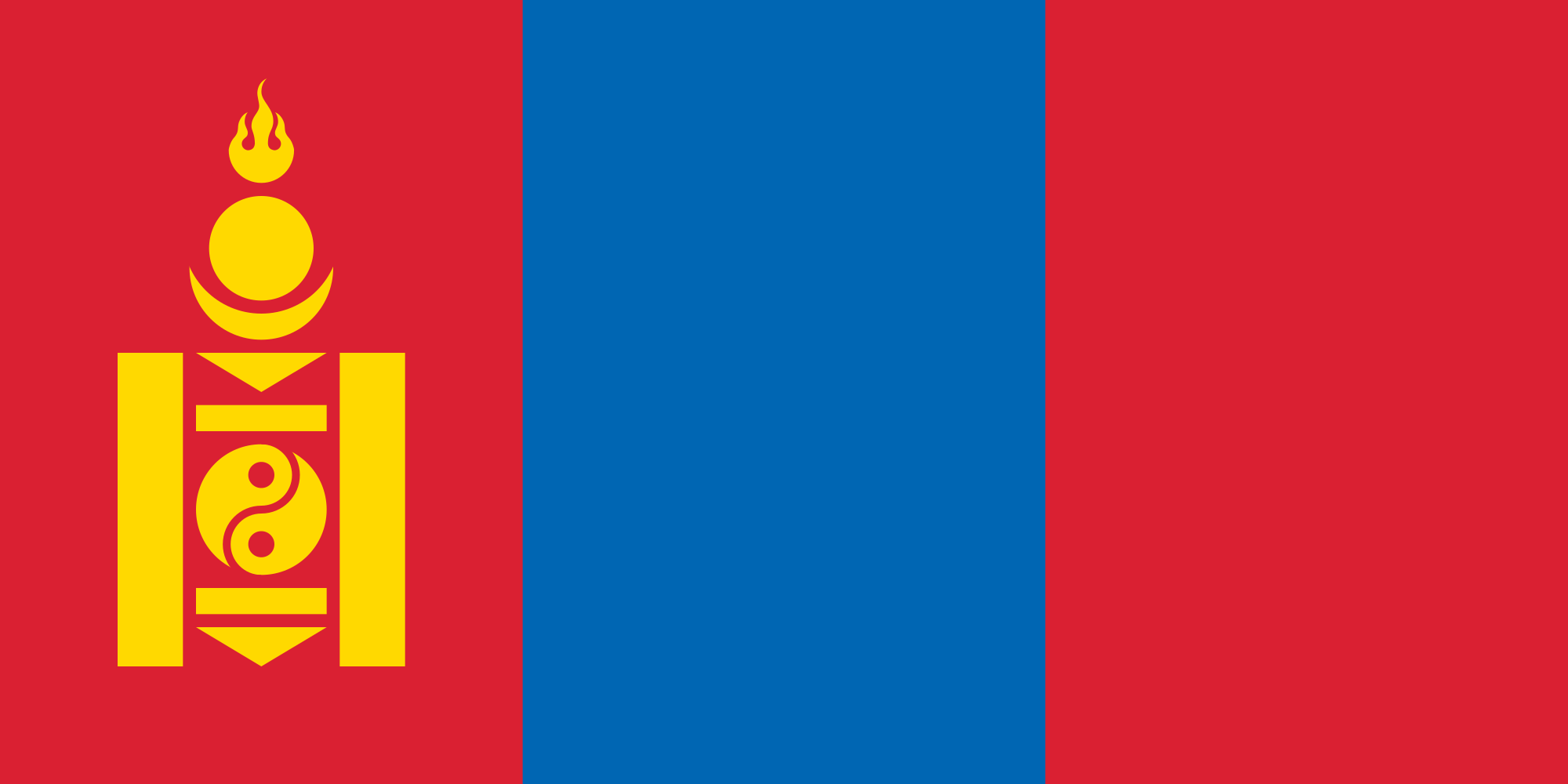 蒙古
蒙古
 缅甸
缅甸
 尼泊尔
尼泊尔
 新西兰
新西兰
 巴基斯坦
巴基斯坦
 菲律宾
菲律宾
 韩国
韩国
 新加坡
新加坡
 斯里兰卡
斯里兰卡
 塔吉克斯坦
塔吉克斯坦
 泰国
泰国
 土库曼斯坦
土库曼斯坦
 乌兹别克斯坦
乌兹别克斯坦
 越南
越南

ボアオ・アジア・フォーラム(博鰲アジアフォーラム、Boao Forum for Asia、略称BFA、中国語:博鳌亚洲论坛、ピンイン:Bóáo Yàzhōu Lùntán)は、中華人民共和国に本拠を置く国際非営利組織。
スイスのダボスで開催されている世界の政治家・財界人・知識人が集まる国際会議(ダボス会議)を主催する世界経済フォーラムにならい、そのアジア版を目指して、中国政府の全面的支援を受けて構想された。2001年2月27日の設立にはアジアの25カ国とオーストラリアの計26カ国が参加している。
ボアオ・アジア・フォーラム主催の最初の国際会議は2002年4月12日・4月13日に開催され、日本からは小泉純一郎内閣総理大臣が出席して演説を行った[1]。国際会議の会場は、2001年の発足会議以来、中国・海南省の海浜リゾート地・ボアオ(博鰲、海南島東海岸の瓊海市)に固定されている。会議は毎年行われ、各国首脳や大企業経営者、学者、NGO代表など政府・民間のハイレベルの人材が集い、アジアや世界の経済動向、金融政策、経済統合、経済投資、国際協力、社会問題、環境問題などに関する討議が行われる。また多くの経済人や政治家、社会運動家らが直接話し合い、国家間協力や企業提携などのトップ会談が持たれる。 過去の議題には中国の世界貿易機関(WTO)への加入問題、90年代後半のアジア金融危機問題などが取り上げられ、2004年には中国の地政学的な「和平崛起」(平和的台頭)戦略の可否が議題となった。
The Boao Forum for Asia (BFA; Chinese: 博鳌亚洲论坛; pinyin: Bó'áo Yàzhōu Lùntán) is a non-profit organisation that hosts high-level forums for leaders from government, business and academia in Asia and other continents to share their vision on the most pressing issues in this dynamic region and the world at large. BFA is modelled on the World Economic Forum held annually in Davos, Switzerland. Its fixed address is in Bo'ao, Hainan province, China, although the Secretariat is based in Beijing. The forum, sometimes known as the “Asian Davos”, takes its name from the town of Boao, located in China’s southern Hainan province, which has been the permanent venue for its annual conference since 2002.[1]
The Forum is committed to promoting regional economic integration and bringing Asian countries even closer to their development goals. Initiated in 1998 by Fidel V. Ramos, former President of the Philippines, Bob Hawke, former Prime Minister of Australia, and Morihiro Hosokawa, former Prime Minister of Japan, the Boao Forum for Asia was formally inaugurated in February 2001. The founding of the BFA was driven by the People's Republic of China and founded by 26 Asian and Australasian states on 27 February 2001. The organisation held its first meeting from 12–13 April 2002.
Discussions at the BFA focus on economics, integration, cooperation, society and the environment. In the past the forum also addressed China's entry into the World Trade Organization, as well as Southeast Asia's economic crisis during the 1990s. The geopolitical strategy 'China's peaceful rise' was a topic of discussion for the forum in 2004. In addition to its annual meeting, the BFA also sponsors other forums and meetings related to Asian issues.
El Foro de Boao para Asia (en chino: 博鳌亚洲论坛, pinyin: Bó'áo Yàzhōu Lùntán), conocida también por sus siglas en inglés BFA, es una organización no lucrativa que organiza foros de alto nivel para líderes del gobierno, los negocios y la academia en Asia y otros continentes para compartir su visión sobre los asuntos más apremiantes en esta región y en el mundo entero. El Foro Boao es el modelo del Foro Económico Mundial que se celebra anualmente en Davos, Suiza. Tiene su sede en Bo'ao, Hainan, China, aunque la Secretaría se encuentra en Pekín.
El Foro tiene como objetivos promover la integración económica regional y acercar a los países asiáticos hacia sus metas de desarrollo.1 Fue creado en 1998 por Fidel V. Ramos, expresidente de Filipinas, Bob Hawke, ex primer ministro de Autralia y Morihiro Hosokawa, ex primer ministro de Japón.2 El Foro de Boao para Asia fue formalmente inaugurado en febrero de 2001. La creación del foro fue liderado por la República Popular de China y fundada por 26 países de Asia y Australasia el 27 de febrero de 2001. La organización tuvo su primera reunión el 12 y 13 de abril de 2002.
Las discusiones del Foro Boao se centran en economía, cooperación, sociedad y medio ambiente. En e pasado el foro también abordaba el ingreso de China en la Organización Mundial del Comercio, así como la crisis financiera asiática de los años noventa. Además de su reunión anual, el foro también patrocina otros foros y reuniones relacionados con temas asiáticos.
Боаоский Азиатский Форум, БАФ (кит: 博鳌亚洲论坛; пиньинь: Bó'áo Yàzhōu Lùntán, англ: Boao Forum for Asia, аббр: BFA), также известен как «Восточный Давос» — неправительственная и некоммерческая международная организация, имеющая своей целью поддержку и развитие экономического обмена, взаимодействия и сотрудничества как в Азии, так и за её пределами путём проведения ежегодных встреч высокого уровня с участием представителей правительственных, деловых, промышленных и научных кругов и обсуждения актуальных экономических, социальных, экологических и др. проблем.
Учреждён в 2001 году. Ежегодные конференции в Боао проводятся с 2002 года.
Главный офис организации находится в г. Боао, пров. Хайнань, КНР.
В 2018 году Боаоский азиатский форум /БАФ/ пройдет 8-11 апреля. Главными темами мероприятия станут реформы, открытость, инновации и "Пояс и путь"[1].

Der Golf von Bohai (chinesisch 渤海, Pinyin Bó Hǎi ‚Bo-Meer‘), auch Bohai-Golf, Bohai-Meer, die Bohai-See oder kurz Bo Hai, früher Golf von Tschili oder Golf von Petschili genannt, ist ein Randmeer des Gelben Meeres im Nordosten der Volksrepublik China. Bedeutende Städte am Golf sind Tianjin und Dalian. Es ist der nächstgelegene Meereszugang der Hauptstadt Peking. Seine Fläche beträgt 78.000 km². Der Gelbe Fluss mündet in den Golf von Bohai.
Im Norden befindet sich die Liaodong-Bucht, im Westen die Bohai-Bucht und im Süden die Laizhou-Bucht.
Im Golf von Bohai befinden sich mehrere der größten Seehäfen Chinas: Der Hafen Qinhuangdao, der Hafen Tianjin, der Hafen Dalian sowie der Hafen Yingkou Bayuanquan.
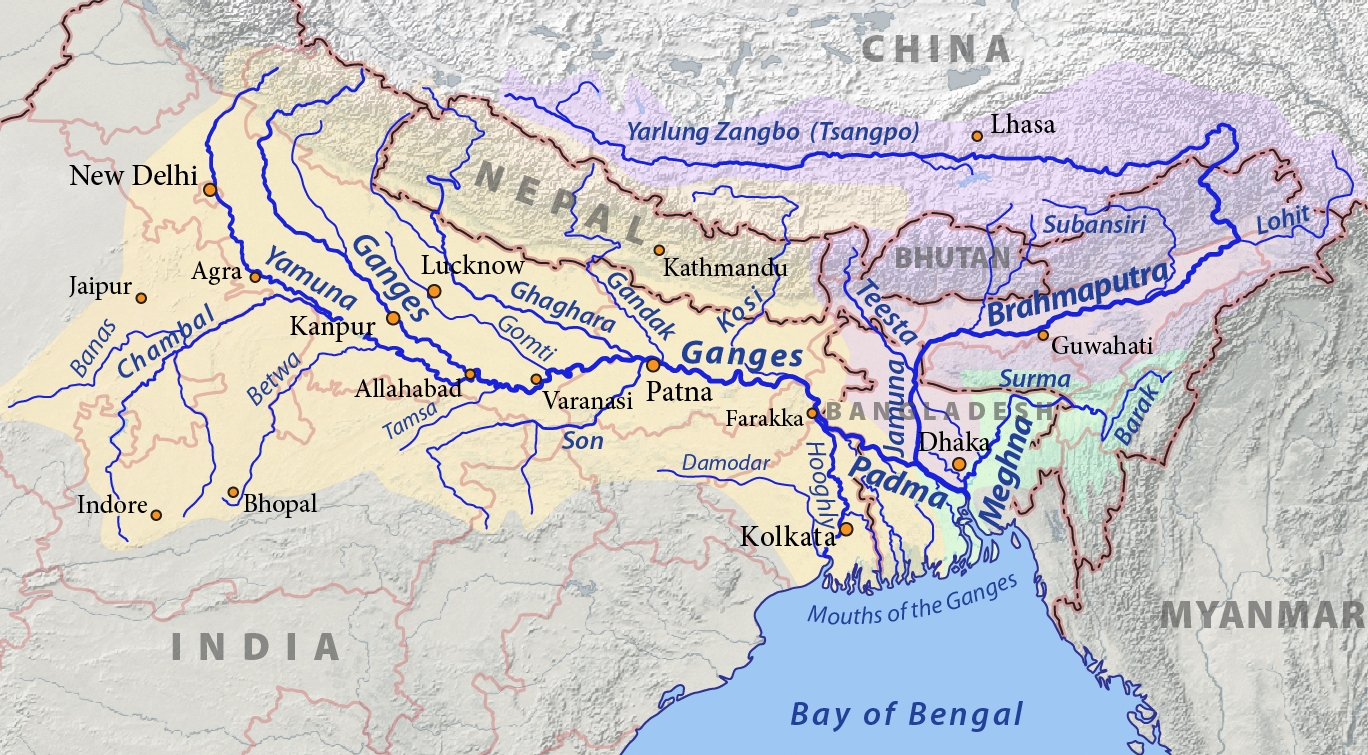
布拉马普特拉河,亚洲主要大河之一,被藏族视为“摇篮”和“母亲河”。以长度来说为中国第5大河(仅次于长江、黄河、黑龙江和珠江)、西藏地区第一大河,以水量来说是印度和孟加拉国的第二大河(仅次于恒河)。上游是世界海拔最高的大河,也是中国坡降最陡的大河。藏语中雅鲁藏布江意为“高山流下的雪水”,梵语中布拉马普特拉河意为“梵天之子”。它发源于西藏喜马拉雅山脉北麓的杰马央宗冰川,从藏南(印度称阿鲁纳恰尔邦)进入印度,在藏南(阿鲁纳恰尔邦)境内称底杭河(Dihang river)或香江(Siang river)。在藏南巴昔卡附近的印度阿萨姆邦境内与其他两河合流后始称布拉马普特拉河。流经孟加拉国后称为贾木纳河,于瓜伦多卡德与恒河汇合,形成巨大的恒河三角洲,最后注入孟加拉湾。全长为2900公里。
布拉马普特拉河(梵語:ब्रह्मपुत्र,印地語:ब्रम्हपुत्र)字面意思是“(印度教三主神之一的)梵天之子”,南亚的一条重要国际河流。
布拉马普特拉河的上游在中国境内,称为雅鲁藏布江,长2057km;流入印度后称为布拉马普特拉河,长644km;流入孟加拉国后称贾木纳河,长240km;在阿里恰与恒河汇流后称帕德玛河,长100km;在琴德普尔与梅格纳河汇合后仍称梅格纳河长241km;最后注入孟加拉湾。以水量、长度来说,此河是南亚第一大河。包括上游雅鲁藏布江在内的全长为2900公里。总流域面积6.22×105km2,流域国有中国、印度、不丹、孟加拉国,四国分别占该河流域面积的51.1%、34%、6.7%、8.2%。
Der Brahmaputra ist der Hauptstrang des als Meghna in den Indischen Ozean mündenden wasserreichsten Stromes in Asien. Er fließt mit einer Länge von rund 3100 Kilometern bis zum Zusammenfluss mit dem Ganges durch das Gebiet der Staaten China, Indien und Bangladesch. Sein Lauf ist teils veränderlich, teils schwer zugänglich und quert mehrere Kulturräume, was zu vielen unterschiedlichen Namen für Teilabschnitte geführt hat.
Der nach Osten gerichtete Oberlauf des Brahmaputra in Tibet heißt auf Tibetisch Matsang bzw. Tachog Tsangpo (in Wylie-Transliteration: rta mchog gtsang po), auf Chinesisch Mǎquán Hé 馬泉河 / 马泉河; danach heißt er auf Tibetisch Yarlung Tsangpo ཡར་ཀླུང་གཙང་པོ (yar klung gtsang po), der Reinigende, nach anderer Quelle „vom höchsten Gipfel herabkommendes Wasser“, und auf Chinesisch Yǎlǔ Zàngbù Jiāng 雅魯藏布江 / 雅鲁藏布江.
Im indischen Bundesstaat Arunachal Pradesh hat der scharf nach Süden abgeknickte Fluss den Namen Dihang oder Siang. Nach einem Richtungswechsel nach Westen an der Einmündung des größten Nebenflusses, des Lohit, heißt er, nun den Bundesstaat Assam durchfließend, Brahmaputra (ब्रह्मपुत्र), was im Sanskrit „Sohn des Brahma“ bedeutet. Ein älterer Name dieses Flussabschnittes war (in Sanskrit-Schriften und in Teilen Assams) Luit oder Lohitya, da früher statt des größeren Dihang der Lohit als der Oberlauf galt. Heute wird der Name auf Hindi ब्रह्मपुत्र, Brahmaputra gesprochen, auf Assamesisch ব্ৰহ্মপুত্ৰ und auf Bengalisch ব্রহ্মপুত্র Brohmoputro.
Bei einer Wendung nach Süden tritt der Fluss in das Staatsgebiet von Bangladesch ein und führt teils ab dort, teils ab der Abzweigung des Alten Brahmaputra (früher der Hauptstrom) den Namen Jamuna. Ab dem Zusammentreffen mit dem deutlich weniger voluminösen Ganges schwenkt der Strom in dessen südöstliche Richtung ein und heißt nun Padma, bis er ab der Mündung des letzten großen Nebenflusses bis zur Mündung in den Golf von Bengalen dessen Namen Meghna annimmt.
ブラマプトラ川(ブラマプトラがわ、英:Brahmaputra River, ヒンディー語:ब्रह्मपुत्र Bramhaputra, ベンガル語:ব্রহ্মপুত্র Brohmoputro)は、チベットに発しバングラデシュでガンジス川と合流し、ベンガル湾へ注ぐ河川である。チベットではヤルンツァンポ川(表記によってはヤル・ツアンポー川とも。チベット語:ཡར་ལུང་གཙང་པོ་ Yar-lung gTsang-po, 中国語:雅鲁藏布江)、バングラデシュではジョムナ川(英:Jamuna River, ベンガル語:যমুনা Jomuna)と呼ばれている。 全長2,900km。源流はヒマラヤ山脈の北側で、マーナサローワル湖から流れでてチベット高原南部を東進した後ヒマラヤ山脈東端をかすめ南下、インドのアッサム州を西へ向け横断、ガンジスに合流する。その合流点では世界最大の広大な三角洲を形成している。中流から下流域にかけて堆積平野が広がり、主に農業が営まれる。雨季にはしばしば氾濫し、氾濫のためにできた沼沢地や池が残る。
The Brahmaputra (/ˌbrɑːməˈpuːtrə/) is one of the major rivers of Asia, a trans-boundary river which flows through China, India and Bangladesh. As such, it is known by various names in the region: Assamese: লুইত luit [luɪt], ব্ৰহ্মপুত্ৰ নৈ Brohmoputro noi, ব্ৰহ্মপুত্ৰ নদ (the tatsama 'নদ' nod, masculine form of the tatsama 'নদী' nodi "river") Brohmoputro [bɹɔɦmɔputɹɔ]; Sanskrit: ब्रह्मपुत्र, IAST: Brahmaputra; Tibetan: ཡར་ཀླུངས་གཙང་པོ་, Wylie: yar klung gtsang po Yarlung Tsangpo; simplified Chinese: 布拉马普特拉河; traditional Chinese: 布拉馬普特拉河; pinyin: Bùlāmǎpǔtèlā Hé. It is also called Tsangpo-Brahmaputra (when referring to the whole river including the stretch within Tibet).[2] The Manas River, which runs through Bhutan, joins it at Jogighopa, in India. It is the ninth largest river in the world by discharge, and the 15th longest.
With its origin in the Manasarovar Lake region, located on the northern side of the Himalayas in Burang County of Tibet as the Yarlung Tsangpo River,[1] it flows across southern Tibet to break through the Himalayas in great gorges (including the Yarlung Tsangpo Grand Canyon) and into Arunachal Pradesh (India).[3] It flows southwest through the Assam Valley as Brahmaputra and south through Bangladesh as the Jamuna (not to be mistaken with Yamuna of India). In the vast Ganges Delta, it merges with the Padma, the popular name of the river Ganges in Bangladesh, and finally the Meghna and from here it is known as Meghna before emptying into the Bay of Bengal.[4]
About 3,848 km (2,391 mi)[1] long, the Brahmaputra is an important river for irrigation and transportation. The average depth of the river is 38 m (124 ft) and maximum depth is 120 m (380 ft). The river is prone to catastrophic flooding in the spring when Himalayas snow melts. The average discharge of the river is about 19,800 m3/s (700,000 cu ft/s),[3] and floods can reach over 100,000 m3/s (3,500,000 cu ft/s).[5] It is a classic example of a braided river and is highly susceptible to channel migration and avulsion.[6] It is also one of the few rivers in the world that exhibit a tidal bore. It is navigable for most of its length.
The river drains the Himalaya east of the Indo-Nepal border, south-central portion of the Tibetan plateau above the Ganga basin, south-eastern portion of Tibet, the Patkai-Bum hills, the northern slopes of the Meghalaya hills, the Assam plains, and the northern portion of Bangladesh. The basin, especially south of Tibet, is characterized by high levels of rainfall. Kangchenjunga (8,586 m) is the only peak above 8,000 m, hence is the highest point within the Brahmaputra basin.
The Brahmaputra's upper course was long unknown, and its identity with the Yarlung Tsangpo was only established by exploration in 1884–86. This river is often called Tsangpo-Brahmaputra river.
The lower reaches are sacred to Hindus. While most rivers on the Indian subcontinent have female names, this river has a rare male name, as it means "son of Brahma" in Sanskrit (putra means "son").[7]
Le Brahmapoutre - du sanskrit ब्रह्मपुत्र (Brahmaputra) signifiant « fils de Brahmâ »3 - est un fleuve de l'Asie du Sud, long de 2 900 kilomètres, ayant sa source principale dans l'Himalaya tibétain, à 5 542 m d'altitude, au glacier Gyima Yangzoin, dans le xian de Zhongba 29° 17′ 41″ N, 83° 46′ 23″ E 4. D'autres sources sont situées au pied des glaciers des monts Kubi-gangri et Ganglung-gangri. C'est le Dyardanes ou l’Œdanes des Grecs anciens. Son parcours tropical fait de la vallée de ce fleuve un des plus riches sites mondiaux au regard de la biodiversité. Ses crues importantes permettent une fertilisation du sol mais sont dévastatrices. Dans son cours inférieur, qui est sacré pour les hindous, le fleuve est utilisé pour le transport de produits agricoles.
Il Brahmaputra (ཡར་ཀླུང་གཙང་པོ་ in tibetano, 布拉马普特拉河 in cinese) è un fiume che nasce nel Tibet sud-occidentale, dove prende il nome Yarlung Tsangpo, e scorre verso est, lungo il versante settentrionale dell'Himalaya, in territorio cinese. Dopo avere aggirato la catena himalayana, piega bruscamente a sud, e col nome di Brahmaputra attraversa gli stati indiani dell'Arunachal Pradesh e dell'Assam, entrando poi nel Bangladesh, dove confluisce nel Gange in corrispondenza del delta di questo per sfociare nel golfo del Bengala.
È lungo 2.900 km, ha una profondità media di 38 metri e massima di 120, si dirama spesso in un intreccio di bracci soggetti a fenomeni di avulsione ed è uno dei pochi fiumi al mondo in cui si verifica la cosiddetta marea fluviale. Il suo bacino idrografico copre una superficie di 670.000 km².[1]
Ha un regime idrico caratterizzato da portata sempre elevatissime: le minime non scendono mai sotto i 5.000 m³/s, ma le massime possono raggiungere anche i 168.500 m³/s, si tratta di portate massime che trovano paragone solo nel Rio delle Amazzoni ed in pochissimi altri fiumi del pianeta. Durante l'estate, quando lo scioglimento dei ghiacciai coincide con l'arrivo del monsone, il fiume è soggetto a catastrofiche esondazioni, che insieme a quelle del Gange allagano intere regioni e sommergono buona parte del Bangladesh, causando ingenti perdite di vite umane e gravissimi danni alle abitazioni e all'agricoltura.[2]
È navigabile per buona parte del suo corso, ma nell'ultima parte del tratto tibetano è caratterizzato da un corso assai impetuoso, con rapide e cascate (una, alta circa 35 metri, è stata scoperta dopo il 2000 nel corso di un'esplorazione britannica). A causa delle gole inaccessibili che attraversa in questa zona disabitata, per lungo tempo non si seppe che il Brahmaputra e lo Yarlung fossero lo stesso fiume, la continuità tra i due corsi è stata scoperta da un'esplorazione compiuta tra il 1884 ed il 1886.
El río Brahmaputra (en idioma sánscrito, ब्रह्मपुत्र, que significa «el hijo de Brahmā») es uno de los ríos más largos de Asia.
Nace en el glaciar Kubigangri, cerca del monte Kailāsh, en el Himalaya, y discurre en dirección este por territorio chino, por la parte oeste del Tíbet, pasando cerca de Lhasa. Después de un recorrido de 2896 km desagua en el golfo de Bengala, en Bangladés, formando parte del delta del Ganges, el mayor delta del mundo. El río es conocido como Tsangpo en el Tíbet y en la zona central de Bangladés se divide en dos ramales, siendo el principal el río Jamuna, nombre con el que es conocido en esa región, y el otro, de menor caudal, el río Shitalakshya.
Es el Dyardanes o "Œdanes" de los antiguos griegos. Su recorrido por la zona tropical hace de su valle uno de los más ricos en diversidad biológica del mundo. Sus principales inundaciones permiten la fertilización del suelo, aunque son devastadoras. En su parte más baja, el río se considera sagrado para los hindúes, y se utiliza para el transporte de productos agrícolas.
Брахмапу́тра[2] (кит. 雅鲁藏布江, тиб. ཡར་ཀླུང་གཙང་པོ།, хинди ब्रह्मपुत्र, ассам. ব্ৰহ্মপুত্ৰ, англ. Brahmaputra, бенг. ব্রহ্মপুত্র) — река в Китае, Индии и Бангладеш, левый приток Ганга; одна из крупнейших водных артерий в Южной Азии.




 财政金融
财政金融

 音乐
音乐

 运输和交通
运输和交通
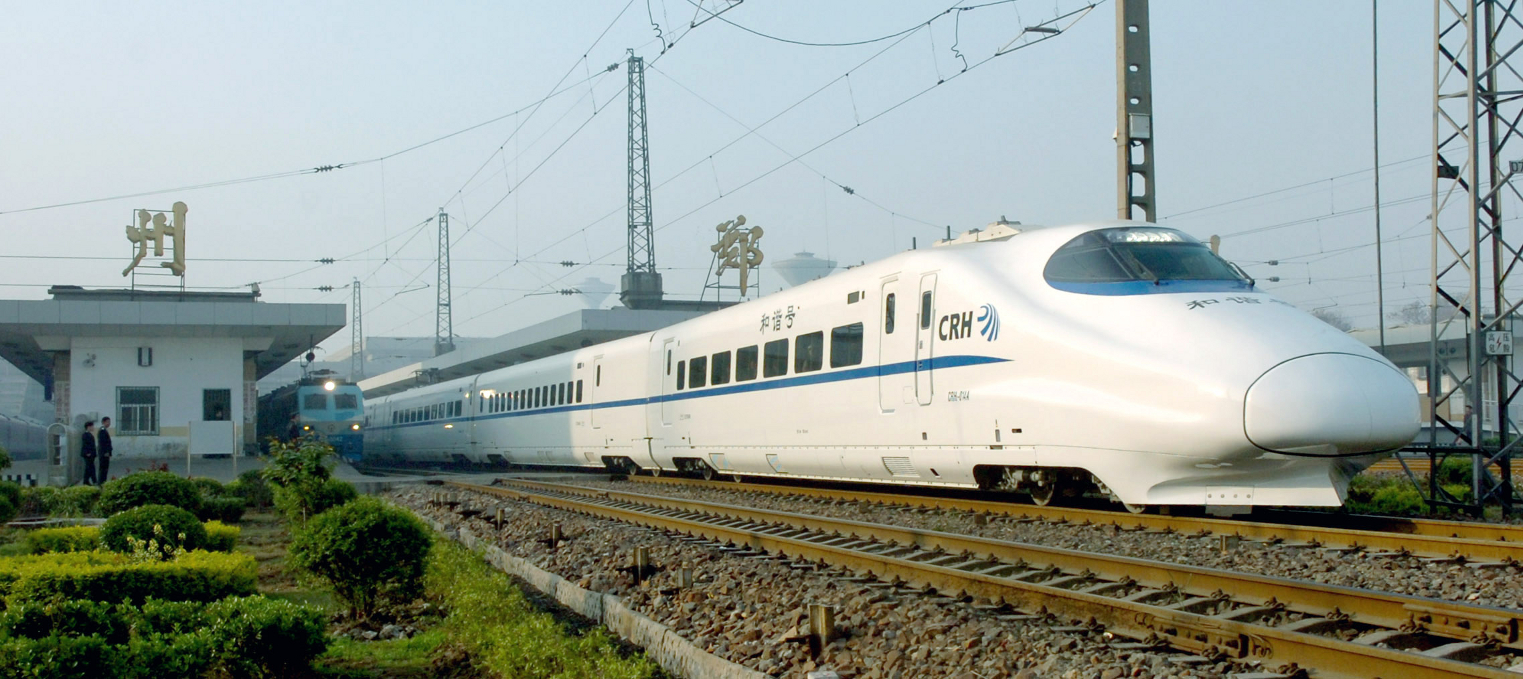
 重要港口
重要港口
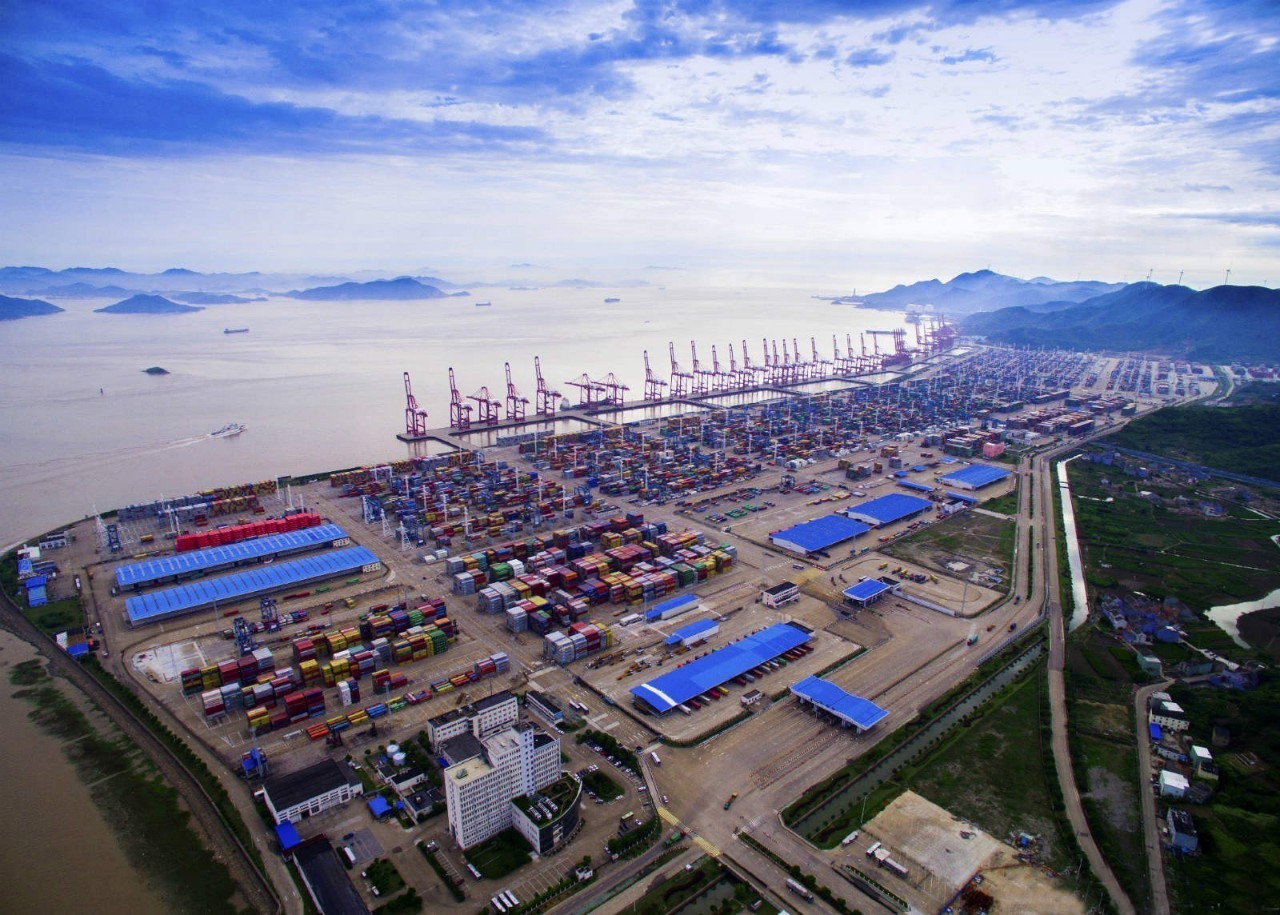
 建筑艺术
建筑艺术

 企业
企业



 军事、国防和装备
军事、国防和装备
 船舶和航海学
船舶和航海学

 地理
地理